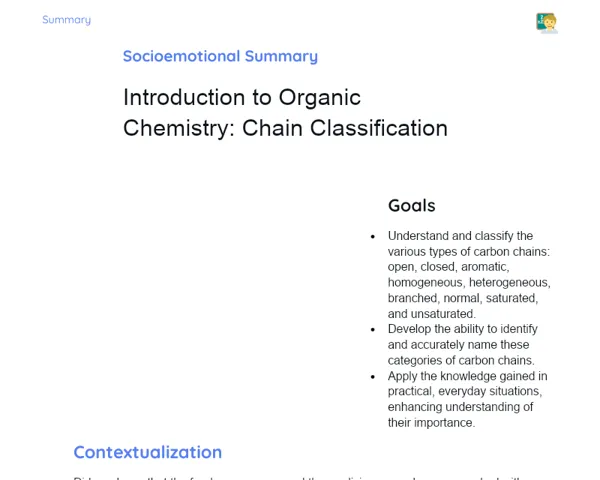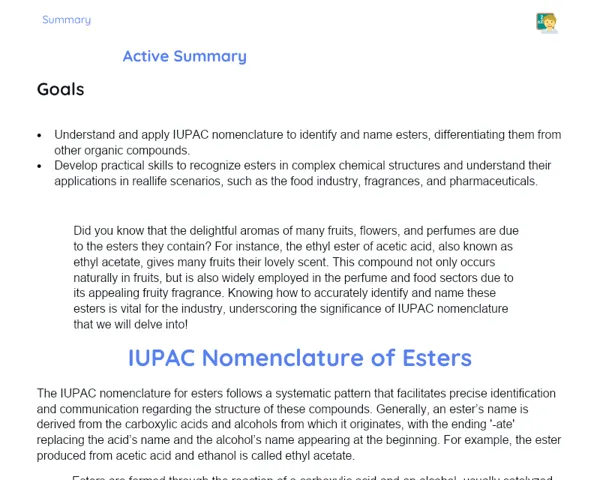Objectives
1. 🎯 Master the IUPAC naming conventions for carboxylic acids, distinguishing them from other organic functional groups.
2. 🔍 Develop analytical skills to accurately identify and name carboxylic acids in various organic compounds.
3. 🌐 Understand the significance of carboxylic acids in diverse industrial and biological contexts.
Contextualization
Did you know that carboxylic acids are not only key players in organic chemistry but also important in our everyday lives? For instance, acetic acid, which you'll find in vinegar, is used both as a food preservative and in manufacturing materials like plastics and fibers. Furthermore, several medications, such as aspirin, are derived from carboxylic acids. This category of compounds is incredibly versatile and fundamental across different sectors, which makes understanding their nomenclature and properties all the more important.
Important Topics
IUPAC Nomenclature of Carboxylic Acids
The IUPAC nomenclature provides a standardized method for naming chemical compounds, including carboxylic acids. The name is derived from the longest carbon chain containing the carboxyl group (COOH), with the suffix 'oic' added. The location of the carboxyl group is indicated by numbering the carbon chain, starting from the end closest to the functional group.
-
The COOH functional group is the defining feature of carboxylic acids.
-
To indicate the presence of the acid, the name of the main chain must end in 'oic'.
-
The position of the carboxyl group is denoted by the lowest possible numbering, starting from the end that yields the smallest number for the carbons bonded to the functional group.
Properties and Reactions of Carboxylic Acids
Carboxylic acids are characterized by their acidic properties, particularly noticeable in aqueous solutions. They react with bases to produce salts and water, a process known as neutralization. Additionally, they may undergo esterification to form esters and decarboxylation, during which they lose carbon dioxide to form aldehydes or ketones.
-
They react with bases to yield salts and water, typical of a neutralization reaction.
-
In the presence of alcohols, they participate in esterification to create esters.
-
During decarboxylation, they release CO2, leading to the formation of aldehydes or ketones based on the structure of the starting compound.
Practical Applications of Carboxylic Acids
Carboxylic acids have a wide range of practical uses, from flavour and fragrance production to the synthesis of pharmaceuticals and polymers. For example, butyric acid is used to produce butter flavour, while acetylsalicylic acid (aspirin) serves as a well-known pain reliever. They are fundamental in the food, cosmetic, and pharmaceutical industries.
-
They are essential in creating flavours and fragrances due to their unique characteristics.
-
Many carboxylic acids serve as precursors for the synthesis of important pharmaceuticals.
-
They are utilized in polymer manufacturing, like polyester, which is developed through polycondensation reactions involving alcohols.
Key Terms
-
COOH Functional Group: A characteristic of carboxylic acids, comprised of a carbon atom bonded to one oxygen double bond and one single-bond oxygen (hydroxyl group).
-
IUPAC Nomenclature: A globally recognized system for naming chemical compounds to ensure consistency in chemical nomenclature.
-
Esterification: A chemical reaction between an acid and an alcohol resulting in the formation of an ester and water.
For Reflection
-
How does the position of the carboxyl group in a carboxylic acid influence its physical and chemical properties?
-
How can a grasp of IUPAC nomenclature aid in the identification and development of new compounds in pharmaceuticals?
-
Why is it crucial to distinguish carboxylic acids from other organic functional groups when considering practical uses, particularly in food and medicine?
Important Conclusions
-
We summarized the IUPAC nomenclature of carboxylic acids, emphasizing how to accurately identify and name these compounds based on their structure.
-
We examined the properties and reactions of carboxylic acids, learning how they behave in aqueous solutions, form esters, and undergo decarboxylation.
-
We discussed the practical uses of carboxylic acids across various industries, ranging from flavour and fragrance production to pharmaceuticals and polymers.
To Exercise Knowledge
- Create a short video tutorial explaining the nomenclature of a carboxylic acid of your choice, detailing its structure and properties. 2. Draw the structures of five different carboxylic acids and label them correctly with their IUPAC names. 3. Research a commonly used pharmaceutical product and determine whether it contains carboxylic acids in its formulation, clarifying their roles.
Challenge
Chemical Detective Challenge: Use your understanding of carboxylic acids to solve a mystery. Given a set of chemical clues, identify the carboxylic acid involved and relate it to the crime scene. Present your findings in an engaging report!
Study Tips
-
Practice IUPAC nomenclature by trying to name various organic compounds beyond just carboxylic acids to enhance your understanding.
-
Watch virtual lab demonstrations showcasing carboxylic acid reactions to help visualize the concepts discussed.
-
Engage in conversations with your peers about the practical applications of carboxylic acids and their significance in our daily lives, reinforcing your learning in a meaningful context.



